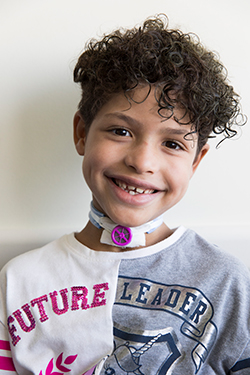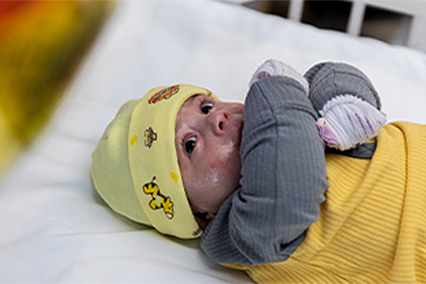Complications of Prematurity: Kieesha’s Story
Meet Kieesha
Kieesha Pentlin started life with the odds stacked against her. Born at 26 weeks’ gestation on Sept. 22, 2011, she weighed just 2 lbs., 2 oz. Though her lungs were severely under-developed, from the very beginning, this tiny baby had a big smile for everyone she met.
“Kieesha just smiles no matter what the circumstances are,” said Dawnda Pentlin, her great grandmother and adopted mom. “From the time she was in the incubator to today, she’s got that smile!”
But Kieesha also struggled to breathe from the moment she was born, a common complication for extremely premature infants.
That’s why she was transferred from a community hospital to the Children’s Mercy Level IV Neonatal Intensive Care Unit (NICU). According to Winston Manimtim, MD, Children’s Mercy Neonatologist and Director of the hospital’s Infant Tracheostomy and Home Ventilator Program, Kieesha required a higher level of neonatal care than was available at the hospital where she was born.
And at Children’s Mercy, the highest level of NICU care was just what Kieesha received.
Complex needs
With an initial diagnosis of respiratory distress syndrome due to extreme prematurity, Kieesha was placed on a ventilator to help her breathe as soon as she arrived in the NICU.
But she faced other medical challenges, including apnea of prematurity, which caused her to have episodes where she would stop breathing. She also had several bouts of lung infection along the way.
Kieesha also had a condition called patent ductus arteriosus (PDA). PDA is a persistent connection between the two major blood vessels leading from the heart. The small blood vessel, called the ductus arteriosus, is a normal part of a baby's circulatory system before birth that usually closes shortly after birth.
If it remains open, which is common in premature babies, it can allow poorly oxygenated blood to flow in the wrong direction. In Kieesha’s case, the PDA was causing her lungs to be “wet” and making it even harder for her to breathe.
Though Kieesha’s PDA was successfully closed surgically when she was 18 days old, her left vocal cord was paralyzed during the procedure, a common complication for about 40% of these patients. As a result, Kieesha also required a feeding tube, or G-tube, to supply her with nutrition.
As Dawnda and her husband, John, kept watch over Kieesha’s progress, over the next few weeks her care became increasingly complex.
The combination of her lung disease, or bronchopulmonary dysplasia, the vocal cord paralysis, and the need for ongoing ventilator support, made it necessary to perform a tracheostomy to help Kieesha breathe.
During the procedure, surgeons made a hole in the front of her neck and into the windpipe (trachea). A tracheostomy tube was then was placed in the hole to keep it open for breathing.
In addition, doctors discovered Kieesha has a minor laryngeal cleft, a small gap or space between the larynx (known as the voice box) and the esophagus (known as the food pipe) that occurs when these structures do not develop normally. Fortunately, because Kieesha’s defect was mild, she didn’t require surgery.
“We weren’t expecting to take care of a baby with so many medical problems,” Dawnda said, “but we went to all the classes the hospital offered so we could learn how to care for her trach and feeding tube. We wanted to be very hands on with Kieesha.”
No place like home!
Six long months after Kieesha had changed Dawnda’s and John’s world, her medical needs were many. She was on oxygen, using a ventilator, had a tracheostomy and a feeding tube, and needed 24-hour nursing support. But, this tiny little girl was still charming everyone with her big smile, and thanks to the Children’s Mercy Infant Tracheostomy and Home Ventilator Program, she was able to finally go home.
Like Kieesha, most babies on the ventilator are discharged from the hospital to home around 6 to 7 months of age. At home, the Infant Tracheostomy and Home Ventilator Program gives patients and their families the opportunity to have a sense of normalcy and thrive in an environment outside the hospital critical care units.
Through the clinic, Kieesha was still able to receive complex medical care and had access to an on-call physician 24/7, as well as the multidisciplinary care team and the support of a local private duty nurse in the home.
She also was followed in the program’s multidisciplinary clinic where all members of the team were available to see her, including neonatology, intensivists, otolaryngology, pulmonology, gastroenterology, physical therapy, occupational therapy, social work and a dietitian.
“When Kieesha went home, she had both a tracheostomy and was on a home ventilator,” Dr. Manimtim said. “Most kids are able to have their trach taken out between 3 and 4 years of age. Kieesha has been off the ventilator for years and her lungs have improved. She graduated from the clinic when she was about 4 ½ years old, but because of her paralyzed vocal cord and narrowing of her airway opening, she still has the trach and her voice is very soft.”
Now 9 years old and in the third grade, Kieesha sees her primary care provider, along with ENT, dermatology and pulmonary subspecialists at Children’s Mercy who manage her medical problems. She takes medications to help with severe allergies and asthma, but all things considered, she’s doing well.
“Kieesha’s case is very complex medically and socially, but she is flourishing,” Dr. Manimtim said.
And so are her three siblings, who were all patients in the Children’s Mercy NICU; two born at 25 weeks’ gestation and one born at 32 weeks’ gestation.
“I commend Dawnda and John for taking great care of not just Kieesha, but her siblings as well,” Dr. Manimtim said.
“Dawnda is good about staying in touch with me, and one Christmas, she sent me a picture of all the kids together, happy and smiling. I tell you, that is one of the most beautiful pictures I have ever seen.”
Still smiling …

Today, Dawnda said Kieesha may still be small for her age, but her big smile and caring spirit more than make up for it. “Kieesha is an absolute caretaker. She’s a very loving child with her siblings, and soft-hearted.”
Though her vocal cords don’t work as well as other kids’, she loves to sing and dance, dress up, play with other kids, do cartwheels, school work, cook and clean.
“Kieesha is strong and strong-willed,” Dawnda said. “We don’t know what her future holds, but she is intelligent and has a great attitude about herself. She says one day she wants to be a chef.”
And one day she might just be, thanks in part to her Children’s Mercy medical team.
“I couldn’t have asked for any better care for that baby girl,” Dawnda added. “Her doctors and nurses treated Kieesha like she was their own.
I credit Children’s Mercy with her survival.”
Epidermolysis bullosa simplex: Jaciel’s story
When Jaciel Ceballas Lemus was born, the skin was missing from the palms of his hands and soles of his feet, and soon blisters, some the size of quarters, covered his body. At Children’s Mercy, he was diagnosed with a rare genetic skin disorder called epidermolysis bullosa simplex (EBS). With dedicated support from his family and medical team, Jaciel’s skin now has healed, and he’s home for the first time since his birth.

Director, Neonatal Outpatient Services; Medical Director, Infant Tracheostomy & Home Ventilator Program; Professor of Pediatrics, University of Missouri-Kansas City School of Medicine
